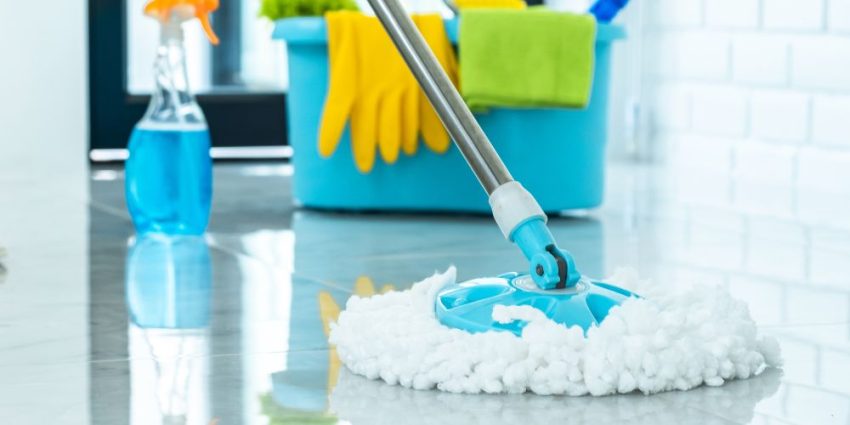For new homebuyers, here’s a reality check: a newly built home is not like a brand new car – shiny and clean. The reality is that you’ll see drywall dust on windowsills, loose screws on the floor, and smudges on glass partitions.
A proper post-construction cleaning plan makes the space safe and ready for work. It removes hazards, protects indoor air, and leaves a fresh look. Below are five must-know tips for effective post-construction cleaning in commercial settings.
1. Start with Top-to-Bottom Dust Removal
When you reach your “constructed” space, you’ll find dust…everywhere. Ceiling tiles, light fixtures, ductwork, and walls – all of this you can expect to be covered in leftover dust. If you clean low surfaces first, dust from above will settle back down. That wastes effort and time. Apply a telescopic microfiber duster on beams and vents that are overhead.
Complete with vacuuming and damp-mopping the floor. This chain captures fine particles less than 0.3 microns and prevents them from traveling back to the air. A staged approach like this sets the stage for the next steps in any construction cleaning plan.
2. Clear and Sort Construction Debris Early
The construction sites abandon plastic waste like pieces of wood, paint cans, and wrappings. These objects obstruct walkways and conceal themselves beneath tools. Arrange a special post-construction clean-up pass prior to the commencement of detailed cleaning. Give different collection bins for landfill waste, recyclable, and reusable materials.
Many of the cities can recycle metal studs and cardboard, and can also offer all the wood or tile unused to the local charities. Label the bins to ensure the hazardous materials are different, i.e., aerosol cans or fluorescent bulbs. Early clearing of the trash also allows your cleaning team free-flowing and avoids the possibility of tripping over people present.
3. Clean Air Vents and Replace HVAC Filters
Dusts might also enter the HVAC system during renovation, sawdust and plaster dust. As you turn on that air handler, that rubbish is flying in every room. First, shut off the system. Remove venture covers and clean them using warm and soapy water. Blow out duct holes with a vacuum hose and brush. Change the entire filters, although the builder may insist that they did.
If you have access to the air handler, clean the coils and drip pans. In case of large projects, use post-construction cleaning companies that have negative-air machines. They ensure that the dust does not get out of the work area and throughout the building.
4. Wash and Disinfect All Hard Surfaces
Sandpaper is similar to dry dust. If you wipe a countertop with a dry cloth, you can leave fine scratches. When wiping a counter, you can leave scratches, which are fine, in an instance when you use a dry cloth. Better still, get dust raised with a barely wet microfiber towel. Next, wipe the material (stone, laminate, or metal) with a pH-neutral reprobate. Target soft touch areas: door handles, elevator controls, lighting switches, and handrails.
After cleaning, spray an EPA-registered disinfectant and let it sit for the full contact time on the label. Missing walls and glass partitions. Even tile back splashes and kick plates gather dirt. This process transforms a dusty shell into a healthy, staff-friendly environment.
5. Give Floors the Final Finishing Touch
Floors take the heaviest wear during building work. Nails and grit can scratch hardwood. Paint drips can harden on concrete. Begin by vacuuming using a brush head by vacuuming to remove loose debris. In the case of a tile, vinyl, or sealed concrete, use a neutral cleaner by mopping.
Use a plastic scraper to lift stuck-on globs. The surface can be scanned by metal tools. If your space has waxable flooring, apply two thin coats of finish. This step adds a barrier against scuffs and wear when chairs roll or carts move.
How Professional Post-Construction Cleaning Services Simplify Your Cleanup
Tackling all these tasks with an internal crew can mean overtime, missed areas, and delays. Commercial construction cleaning services bring trained teams, detailed checklists, and industrial gear. They know how to meet OSHA rules for silica, handle waste disposal records for LEED projects, and leave no tape residue on glass. A pro crew can work while you manage permits, furniture delivery, and tenant move-ins. They often include a final walk-through with blue-tape touch-ups to fix any smudges or paint drips.
Hiring post-construction cleaning services also shifts liability. Insured professionals reduce your risk if someone slips or if a subcontractor’s tool breaks a window during cleanup. Most service providers offer bundled rates that cover dust removal, vent cleaning, hard surface sanitization, and floor finish. That can cost less than paying two or three staff members overtime and renting equipment separately.
An effective post-construction cleaning plan begins with dust management, debris management, ventilation management, surface wash and disinfection, and floor maintenance. One step leads to another and makes sure that the space appears and feels like an accomplished office or a retail store. Companies that do not or hurry through these processes tend to experience lost productivity, sick leave, and callbacks.
Ready for a truly clean hand-off? Moonshine Commercial Cleaning provides professional post-construction clean-up for offices, showrooms, clinics, and warehouses. Our crews carry EPA-approved disinfectants, lift equipment, and HEPA vacuums. We are guided by experience and a well-planned plan, and we deal with the disposal of rubbish, duct cleaning, and finishing floors.
Also read: Top 10 High-Touch Areas in the Office That Require Frequent Cleaning

